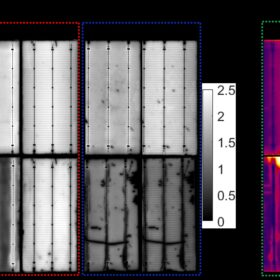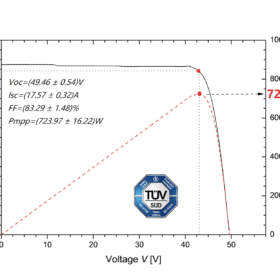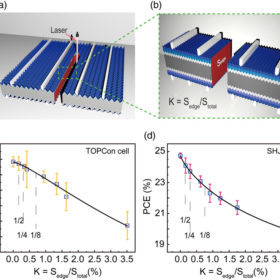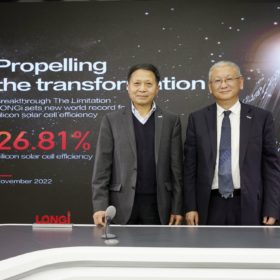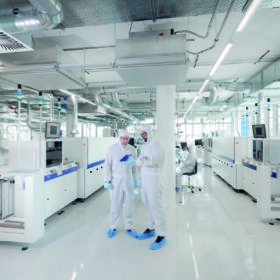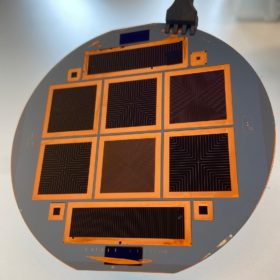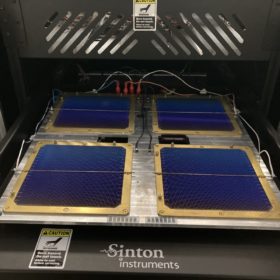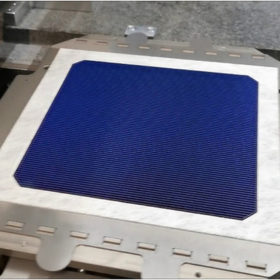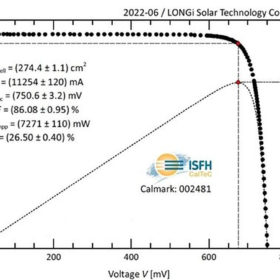Scientists warn of heat-induced failure risks in HJT glass-backsheet PV modules
University of New South Wales researchers have identified four failure modes caused by damp heat in heterojunction solar panels with a glass-back sheet configuration. The failures could result in power losses ranging from 5% to 50%.
Huasun claims 23.30% efficiency, 723.97 W output for utility-scale solar panels
Huasun’s new PV modules have an open-circuit voltage of 49.46 V, a short-circuit current of 17.57 A, and a fill factor of 83.29%. Germany’s TÜV SUD has confirmed the results.
Spray passivation to reduce losses in TOPCon, HJT cell-to-module process
Chinese researchers have developed a new passivation technique for shingled solar panels based on tunnel oxide passivated contacts (TOPCon) or heterojunction (HJT) tech. It reduces recombination losses in the cell-to-module process and reportedly increases open-circuit voltage, fill factor, and efficiency.
Longi claims world’s highest efficiency for silicon solar cells
Longi said it has achieved a 26.81% efficiency rating for an unspecified heterojunction solar cell, as confirmed by Germany’s Institute for Solar Energy Research Hamelin (ISFH).
Fraunhofer ISE develops direct metallization tech for heterojunction solar cells
Germany’s Fraunhofer ISE is applying its FlexTrail-printing technology to the direct metallization of silicon heterojunction solar cells. It said the technique reduces the use of silver, while maintaining high efficiency levels.
Goldi Solar unveils 710 Wp heterojunction PV modules
Indian manufacturer Goldi Solar has unveiled a 710 Wp bifacial solar module based on heterojunction (HJT) technology. The module is built with 132 half-cells and has a conversion efficiency of up to 22.85%.
Heterojunction solar cell with 24.18% efficiency via hydrogenated amorphous silicon passivation
A Dutch research group has developed a passivation technique for heterojunction solar cells based on a hydrogenated amorphous silicon layer. Their cell achieved an in-house-certified power conversion efficiency of 24.18%, an open-circuit voltage of 726.0 mV, a short-circuit current of 39.97 mA/cm2, and a fill factor of 83.3%.
Using p-type wafers in heterojunction solar cells, not a lost battle
An international research group has reconstructed the trajectory of p-type wafers in the heterojunction solar cell segment and has identified the lack of knowledge about boron-oxygen related light-induced degradation (BO-LID) as the main cause for the limited adoption of these wafers and the success of their n-type counterparts. According to the scientists, however, there is still big room for improvement for p-type technologies in heterojunction cells.
Heterojunction solar cells with lower silver consumption via rotary screen printing
Scientists from the Fraunhofer ISE built a bifacial heterojunction solar cell with a power conversion efficiency of 21.7% via rotary screen printing. They used a machine that is able to achieve a cycle time of just 0.6 seconds per solar cell and enables a strong reduction in silver use.
Longi’s heterojunction solar cell hits 26.5%
Germany’s Institute for Solar Energy Research Hamelin has confirmed that Longi’s new n-type heterojunction solar cell has achieved a power conversion efficiency of 26.5%.
